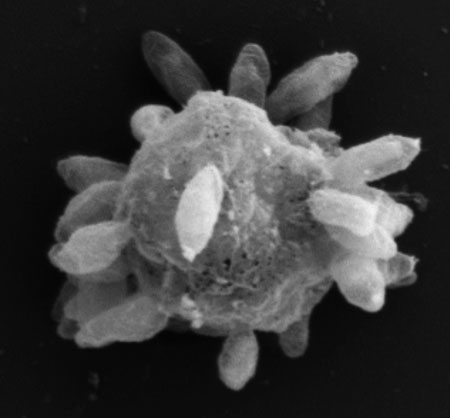More and more evidence suggests that these tiny algae interact with bacteria in various ways. However, so far, no one had documented a direct interaction between bacteria and a member of this key group of algae.

Figure: Scanning electron microscopy (SEM) image of cells from an algal-bacterial co-culture.
Now, in a controlled laboratory environment, Segev et al. show that marine bacteria from the Roseobacter group physically attach onto a tiny coccolithophore alga called Emiliania huxleyi. While the bacteria are attached to their algal host, they enjoy a supply of nutrients that trickles from the algal cell. Unexpectedly, Segev et al. also discovered that the algae grow better in the presence of the bacteria. It turns out that the bacteria use a molecule that they obtain from their algal hosts to produce a small hormone-like molecule that in turn enhances the growth of the algae. However, after three weeks of growing together, the bacteria produce so much of the growth-enhancing molecule – which is harmful in higher concentrations – that they actually kill their algal host.
These findings suggest that the bacteria first promote the alga’s growth to boost their supply of nutrients. But as algae grow older, the bacteria harvest the algae to enjoy a last pulse of nutrients and allow their offspring to swim away and attach to younger algae.
The next challenge will be to link these laboratory observations to the actual microbial interactions in the ocean. It will also be important to explore whether other algae and bacteria interact in similar ways and if bacteria contribute to the sudden collapse of algal blooms by killing the algae.
Text and figure first appeared in eLIFE, DOI: http://dx.doi.org/10.7554/eLife.17473, 2016. Dynamic metabolic exchange governs a marine algal-bacterial interaction. Segev et al.
Reference
Dynamic metabolic exchange governs a marine algal-bacterial interaction, Segev E., Wyche P. T., Kim K., Petersen J., Ellebrandt C., Vlamakis H., Barteneva N., Paulson N. J., Chai L., Clardy J., Kolter R., eLIFE, DOI: http://dx.doi.org/10.7554/eLife.17473, 2016.


































